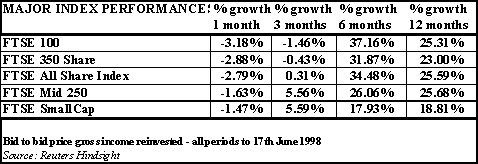| This report covers the 6 month period from 17th December 1997
to 17th June 1998. During this time the shares in the FTSE 100 Index have
performed well overall, recording an increase of 10.38% compared with netPEP’s offer
to offer price performance which showed an increase of 11.18%. The difference is the
accumulation of dividend income which will be distributed to unitholders on the register
as at the end of July. Throughout the period netPEP’s unit price has tracked the
Index very closely and the chart below shows the weekly tracking differences. The
significant ones are tagged on the chart.
Asian crisis
This excellent performance by the Index is attributable to a number of factors, not
least the relative stability of the major western economies that have benefitted from the
flight by investors out of Asian markets which are in crisis. Imagine the panic when a
market like Indonesia can crash by 90% relative to Wall Street. This flight of capital to
the comparative safe haven of the US , UK and European markets has been good for bonds and
yields have been falling rapidly which has pushed equity markets higher.
The Asian crisis has, of course, given UK and US equity investors some cause for alarm.
The shares of companies that export manufactured goods to Asia have been hard hit. Concern
has also been expressed about the prospects for a torrent of cheap imports from Asia on
the back of very cheap currencies resulting from the economic crisis.
Within the top 100 British companies, the performance has been diverse over the past 6
months. Orange heads the leaders list with shares up 87% over the period which compares
with manufacturer GKN whose shares are down 37% in anticipation no doubt about the adverse
effects of problems in Asia. But these performances are exceptional and the combined
effect on the Index overall is very small since together they account for only 1% of the
whole Index.
Sector differences
Looking at sectors, the impact of individual shares is more noticeable. The biggest
sector, Financials (27%) shows an average increase of 4.42% whereas Consumers Goods
(Pharmaceuticals and Food Manufacturers), which account for a total of 18% of the whole,
recorded an average rise of 19%. These figures bear no resemblance to the size-weighted
performances of the sectors which are much more relevant since they reflect a true picture
of the contribution to performance that each sector makes to the Index. Hence Cadbury
Schweppes up 43% which represents 0.88% of the Index contributed less to the Index than
SmithKline Beecham which was up only 12% representing 3.9% of the Index.
| SECTOR |
% of the Index |
Size-weighted performance % |
Average % performance of constituents |
| Consumer Goods |
18.2 |
+ 3.202 |
+ 19.26 |
| Financials |
27.2 |
+ 0.943 |
+ 4.42 |
| General Industrial |
7.3 |
+ 0449 |
- 1.4 |
| Mineral Extraction |
10.4 |
- 0.252 |
- 6.3 |
| Services |
22.9 |
+ 3.464 |
+ 15.6 |
| Utilities |
13.8 |
+ 4.144 |
+ 21.5 |
Arrivals and departures
There have been a number of exits and new entrants to the FTSE 100 Index over the past
6 months reflecting merger and acquisition activity . Commercial Union and General
Accident combined to make CGU, Grand Met and Guinness created Diageo and Nycomed acquired
Amersham. Sparkling share price performance allowed Mysis and Compass to join the elite
group and relative decline in unfashionable sectors caused Imperial Tobacco, Smith &
Nephew, Tate & Lyle and Imperial Tobacco to drop out. Activity like this makes it
difficult to keep the tracking differences of any Index Tracker to within the estimated
limits because the costs of dealing and rebalancing the portfolio are not reflected in the
Index. The results achieved by Barclays Global Investors are very reassuring and
illustrate the importance of being the largest tracking fund managers in the world and
being able as a consequence to negotiate levels of costs and charges which impact very
little on the funds overall performance. The tracking differences since netPEP was
launched are shown below.

Big versus small
The performance of large cap shares versus the small caps has been a subject of raging
debate over recent years with the large caps which make up the FTSE 100 Index
outperforming the rest of the market by a very wide margin. Supporters of small companies
have been pointing to the recent reversal of this trend as illustrated in the table below
where the Mid 250 and the Small Cap indices have shown a rise of + 5.5% over the last 3
months against a modest fall by the FTSE 100 Index over the same period of –1.5%.
Between 16th and 19th June both the SmallCap and the Mid 250 Indices
have lost all of this ground falling 3.3% and 3.1% respectively against the FTSE 100 Index
which rose by 2.7%.

This continuation of the large cap theme is explained by the nervousness of large
foreign institutions. Now the securities industry is truly global their portfolios contain
increasing proportions of overseas investments. Their over-riding concern is to invest in
well researched companies which offer a level of liquidity which small companies cannot
provide. Coupled with the actions of local UK institutions whose portfolios have been
under-performing on account of under-weight positions in the FTSE stocks, the share prices
quickly rebound after short term periods of weakness as UK institutions top up their
holdings to match the Index performance more closely in the future.
Therefore the place to be is the large cap shares just as it has been in America for
the past few years. |